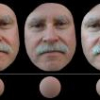Free Online Productivity Tools
i2Speak
i2Symbol
i2OCR
iTex2Img
iWeb2Print
iWeb2Shot
i2Type
iPdf2Split
iPdf2Merge
i2Bopomofo
i2Arabic
i2Style
i2Image
i2PDF
iLatex2Rtf
Sci2ools
CVPR
2003
IEEE
2003
IEEE
Face Relighting with Radiance Environment Maps
A radiance environment map pre-integrates a constant surface reflectance with the lighting environment. It has been used to generate photo-realistic rendering at interactive speed. However, one of its limitations is that each radiance environment map can only render the object which has the same surface reflectance as what it integrates. In this paper, we present a ratio-image based technique to use a radiance environment map to render diffuse objects with different surface reflectance properties. This method has the advantage that it does not require the separation of illumination from reflectance, and it is simple to implement and runs at interactive speed. In order to use this technique for human face relighting, we have developed a technique that uses spherical harmonics to approximate the radiance environment map for any given image of a face. Thus we are able to relight face images when the lighting environment rotates. Another benefit of the radiance environment map is that we ...
Computer Vision | Constant Surface Reflectance | CVPR 2003 | Human Face | Lighting Environment Rotates | Radiance Environment Map | Spherical Harmonics Basis |
| Added | 12 Oct 2009 |
| Updated | 29 Oct 2009 |
| Type | Conference |
| Year | 2003 |
| Where | CVPR |
| Authors | Zhen Wen, Zicheng Liu, Thomas S. Huang |
Comments (0)

